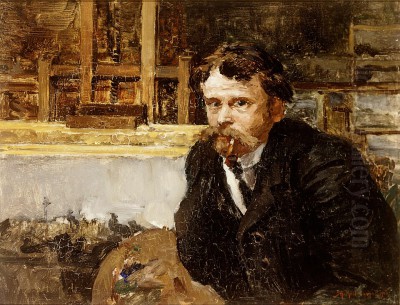
Johan Hendrik van Mastenbroek stands as a significant figure in Dutch art history, renowned primarily for his evocative depictions of the bustling port of Rotterdam during a period of intense transformation. Born in 1875 and passing away in 1945, his life spanned a dynamic era in the Netherlands, marked by industrialization and urban growth, themes that became central to his artistic output. As both a painter and a keen observer, van Mastenbroek captured the energy, atmosphere, and changing landscape of his native city with remarkable skill and sensitivity.
Early Life and Artistic Formation
Johan Hendrik van Mastenbroek was born into an artistic environment in Rotterdam in 1875. His father was not only a painter himself but also a dealer in art supplies and paint materials, providing young Johan with early exposure to the world of art. This familial connection likely nurtured his burgeoning interest in drawing and painting from a young age. It is noted that his brother, Pieter van Mastenbroek, also pursued a career as a painter, focusing on landscapes.
His formal artistic training began relatively early. At the age of fourteen, he was apprenticed to a painter named Van Andel, who specialized in decorative landscapes. This experience provided him with foundational skills in landscape depiction. Concurrently, seeking to further hone his craft, van Mastenbroek attended evening drawing classes at an academy, sessions reportedly organized by his own father. Later, he pursued studies at the prestigious Amsterdam Art Academy, solidifying his technical abilities and broadening his artistic horizons.
From his youth, van Mastenbroek developed a habit of observing and sketching the urban environment, often accompanying his father. This practice instilled in him a deep connection to the city of Rotterdam, particularly its rapidly developing harbor areas, which would become the defining subject of his mature work.
The Rotterdam Focus: Port and City Life
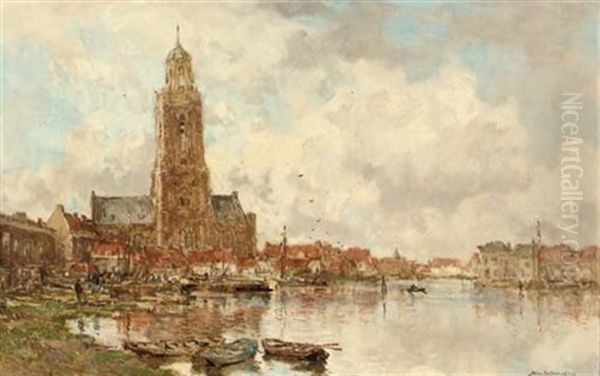
Van Mastenbroek's artistic identity is inextricably linked to the port of Rotterdam. He dedicated much of his career to capturing the multifaceted life of this major European harbor during the late 19th and early 20th centuries. His works serve as invaluable visual documents of a city undergoing profound change, fueled by industrial expansion and maritime trade. He was particularly drawn to the period after 1900, chronicling the technological advancements transforming the port's operations.
His canvases and watercolors are populated with the elements of this dynamic environment: steamships and sailing vessels, cranes and loading docks, tugboats maneuvering through waterways, and the constant movement of workers, carts, and cargo. He possessed a keen eye for the details of harbor activity, depicting the loading and unloading of ships, the interplay of different forms of transport, and the sheer energy of the waterfront.
Beyond the purely industrial aspects, van Mastenbroek was sensitive to the human element and the atmospheric conditions of the city. He depicted the diverse life of Rotterdam, showing how the port influenced the rhythm of the city. His works often capture specific moments in time, reflecting the changing seasons and weather, demonstrating a deep understanding of how these elements affected the appearance and mood of the urban landscape.
Artistic Style and Influences
Johan Hendrik van Mastenbroek's style is primarily rooted in Realism, characterized by careful observation and a commitment to representing the tangible world. He demonstrated considerable skill in perspective, shading, and capturing the intricate details of architecture, machinery, and human figures. His primary mediums were oil painting and watercolor, both of which he employed with technical proficiency.
While grounded in Realism, his work also reveals the influence of significant contemporary art movements, particularly French Impressionism and Post-Impressionism. Echoes of the Barbizon School painters, such as Jean-Baptiste-Camille Corot and Charles-François Daubigny, known for their atmospheric landscapes, can be discerned. The influence of precursors to Impressionism like Eugène Boudin, famed for his coastal scenes and skies, is also noted. Van Mastenbroek absorbed the Impressionists' interest in light, atmosphere, and capturing fleeting moments.
However, van Mastenbroek developed a distinctive personal style. Unlike the often bright palettes of French Impressionists like Claude Monet or Camille Pissarro, he frequently employed a darker, more tonal, and sometimes described as "dreamlike" color palette. This approach lent a unique moodiness and atmospheric depth to his depictions of the often-gritty industrial environment of Rotterdam. His handling of color and light, while influenced by others, remained uniquely his own.
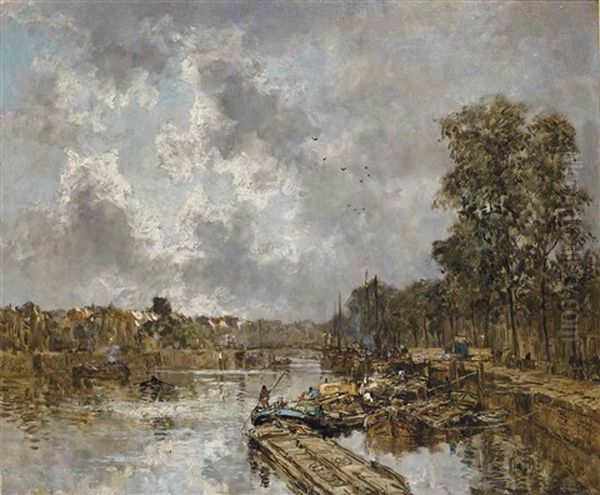
He is also associated with the legacy of the Dutch "Second Hague School," a movement prominent between roughly 1860 and 1900. Artists like Jacob Maris, Anton Mauve, Hendrik Willem Mesdag, Jozef Israëls, and Willem Roelofs defined this school with their realistic, often atmospheric depictions of Dutch landscapes, coastal scenes, and everyday life. While van Mastenbroek's main body of work emerged slightly after the peak of the Hague School, his focus on Dutch subjects and realistic rendering connects him to this tradition, even as his specific focus on Rotterdam's industrial modernity set him apart. He can be seen as extending that realist tradition into the 20th century, alongside contemporaries like the Amsterdam Impressionists George Hendrik Breitner and Isaac Israëls, who also focused on modern urban life.
A notable aspect of his working method was his preference for painting outdoors (en plein air), even in challenging weather conditions. He was known to venture out in rain and snow, believing these conditions offered unique visual beauty and allowed him to capture the effects of weather on light, color, and atmosphere with greater authenticity. This dedication is evident in works that masterfully depict rain-slicked streets or snow-covered docks.
Representative Works
Several works stand out as representative of Johan Hendrik van Mastenbroek's focus and style. Winteriddag (Winter Afternoon or Winter Twilight) exemplifies his ability to capture the specific mood and light of a season within the urban or harbor setting. Similarly, Een regenbui (A Shower of Rain) showcases his fascination with weather effects and his skill in depicting the glistening surfaces and altered colors brought about by rain.
Other significant titles include Canal at Maassluis and Lock at Delfshaven (dated 1918), which highlight his interest in the waterways and infrastructure in and around Rotterdam. Works titled Along the River, Te Rotterdam (In Rotterdam), and Buiten Rotterdam (Outside Rotterdam) further underscore his dedication to documenting the city and its environs. A painting titled The Maas River at the Wilmerskade, known from auction records, points to a specific location along Rotterdam's vital waterway. These works collectively demonstrate his consistent engagement with the port city, its activities, and its atmospheric conditions.
Beyond the Harbor: Versatility in Subject
While Johan Hendrik van Mastenbroek is most celebrated for his depictions of Rotterdam's harbor and city life, his artistic interests were not confined solely to this subject matter. His oeuvre demonstrates a degree of versatility, encompassing other genres that were popular during his time.
He is known to have painted traditional Dutch polder landscapes, capturing the flat, water-rich countryside that contrasts sharply with the urban bustle of Rotterdam. Additionally, he produced hunting scenes, a genre with a long history in Dutch art, and occasionally undertook portraiture. He also explored still life painting. This breadth of subject matter indicates a wider range of artistic exploration beyond his primary focus, showcasing his technical skills across different genres.
Career, Recognition, and Market Presence
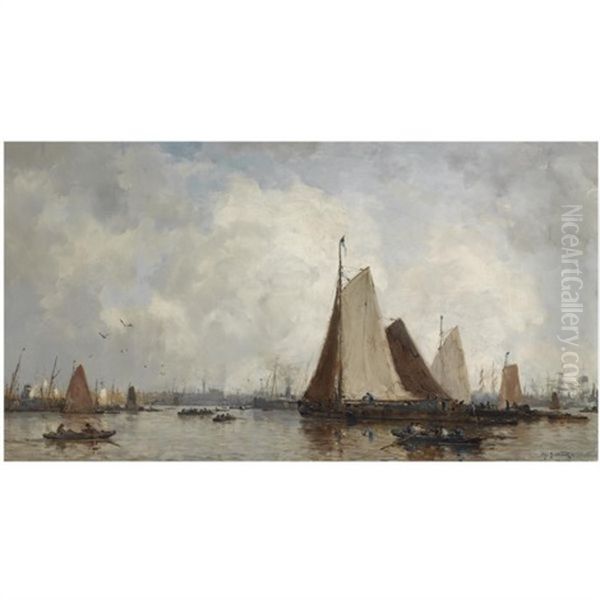
Beyond his identity as a painter, Johan Hendrik van Mastenbroek also functioned as an art dealer. His family background in the art trade likely facilitated this dual role. He reportedly ran an art shop that sold works by artists of the Dutch School (likely referring to the Hague School and related artists) as well as French Impressionist masters. This position would have kept him well-connected within the art world and exposed him to a wide range of contemporary and historical art.
His work gained considerable recognition both within the Netherlands and internationally during his lifetime. He received numerous honors, medals, and awards for his paintings, attesting to the high regard in which his art was held by critics and peers. His paintings found buyers not only in his home country but also abroad, with works entering private collections in countries such as the United States, the United Kingdom, and Switzerland.
This appreciation has continued posthumously. Van Mastenbroek's paintings remain sought after in the art market. They frequently appear at major international auction houses like Christie's and Sotheby's, often achieving significant prices. This enduring market presence reflects his established position within Dutch art history and the continued appeal of his detailed and atmospheric depictions of Rotterdam.
Collections and Legacy
Today, the works of Johan Hendrik van Mastenbroek are held in various public institutions and private collections. In the Netherlands, his paintings can be found in the prestigious Rijksmuseum in Amsterdam. The Stedelijk Museum Schiedam also holds his work and has featured it in exhibitions, such as the noted "Living Landscape" show. Furthermore, the Gemeentearchief Schiedam (Schiedam Municipal Archives) preserves some of his pieces, highlighting his local significance.
His legacy lies primarily in his role as a visual historian of Rotterdam during a critical period of its development. His paintings offer more than just aesthetic pleasure; they provide a window into the past, documenting the transition to an industrial, modern port city. He captured not just the physical structures but also the atmosphere, the labor, and the relentless energy of early 20th-century Rotterdam.
Academic Perspective and Nuances
Academic assessment of Johan Hendrik van Mastenbroek is generally positive, recognizing him as a skilled painter and an important chronicler of his time and place. His realistic style, attention to detail, and mastery of light and atmosphere are widely acknowledged. His works are valued for their historical significance, offering insights into the socio-economic transformations occurring in the Netherlands.
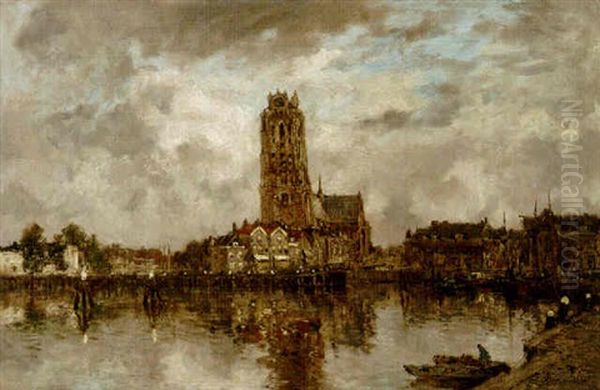
Some nuances and points of discussion exist within the academic view. While his connection to French Realism (including the Barbizon School) and Impressionism is clear, his tendency towards darker, more atmospheric, and sometimes "dreamlike" palettes distinguishes him from many of his French counterparts. This unique color sensibility is a key aspect of his individual style.
Furthermore, the diversity of his subject matter – extending beyond the harbor to landscapes, hunting scenes, and portraits – might be seen by some as slightly diluting his primary focus. However, it also demonstrates his broader capabilities as an artist trained in the traditions of his time. Despite these minor points of discussion, his importance as a painter of Rotterdam's industrial age remains undisputed, reinforced by his continued presence in museum collections and his strong performance in the art market.
Conclusion
Johan Hendrik van Mastenbroek (1875-1945) carved a distinct niche for himself in Dutch art history through his dedicated and insightful portrayal of the port of Rotterdam. Emerging from an artistic family and receiving solid academic training, he combined a realist's eye for detail with an impressionist's sensitivity to light and atmosphere. Influenced by both Dutch traditions and French innovations, he developed a personal style well-suited to capturing the dynamic energy and industrial character of his native city during an era of rapid change. His works, found in museums and collections worldwide, serve not only as compelling artistic achievements but also as invaluable historical documents, preserving the image and spirit of Rotterdam's waterfront for future generations.